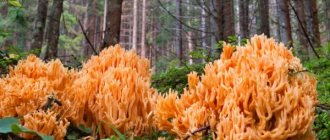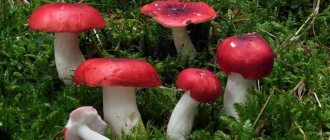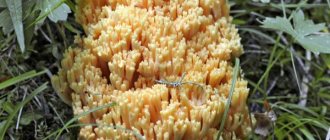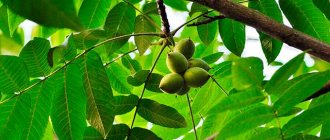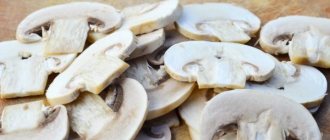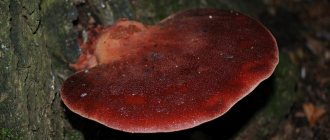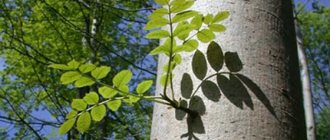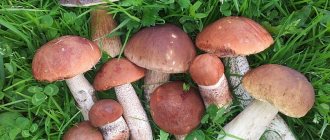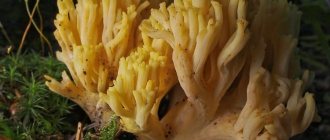Precautionary measures
There are many plants that look like deer legs.
Many of them are quite poisonous. Therefore, if you are new to this business, then ask an experienced mushroom picker to tell and show how to correctly collect and distinguish deer legs from other plants. Remember that after harvesting, before cooking, you must rinse and process them well, because if not prepared correctly, they can have serious negative effects on your body.
Do not harvest near highways, as plants quickly absorb toxic substances.
The mushroom is considered edible, but it is not found in mass preparations; it is not clear what to do with it, but the mushroom is noticeable and it is impossible to simply pass by.
Let's go together (1)
Rogatik reed
(lat. Clavariadelphus ligula) is an edible mushroom from the genus Clavariadelphus.
This mushroom is also called horntail truncated, clavariadelphus reedulata, clubface and posterior reed. The mushroom is noticeable, the fruiting body is club-shaped, does not branch, and is colored in orange-yellow or cream tones. Clubworts prefer to grow only in coniferous forests
, and they settle exclusively under
pine trees
in mosses, possibly forming mycorrhiza with them.
You can find them on the edges, near stumps and tree trunks. Horntails grow in litter, in moss, on wood remains buried in the soil and in densely fallen pine needles. Clubworts bear fruit in groups, sometimes huge, with hundreds or more specimens. Fruiting occurs from July to November
, with active growth occurring in October. Found infrequently, but in large groups.
The mushroom is considered edible, category 4, with low taste. These mushrooms are not harvested en masse anywhere; it is not clear what to do with them. Polysaccharides were isolated from the micellar culture of hornets, which stop the growth of Ehrlich carcinoma and sarcoma-180 by 90%. The mushroom contains melatonin, a precursor of serotonin, and hydroxytryptophan. These mushrooms are natural antibiotics.
The fruiting body of Horntail has neither a stem nor a cap, is vertical, tongue-shaped, somewhat widened in the upper part (sometimes to the shape of a pistil), often slightly flattened; height 7-12 cm, thickness - 1-3 cm (in the widest part). The surface of the fruiting body is smooth at first, but later becomes uneven and wrinkled. The mushroom is hollow inside.
Its base is fleecy-felt. The color of young fruiting bodies is cream or yellow, and then becomes ocher-yellow or orange-yellow; old fruiting bodies are brown with a purple tint. This shade is most noticeable at the base of the mushroom. The head of the club is round or flattened, its diameter is 0.5-3 centimeters. The head narrows noticeably towards the base. The pulp is light, whitish, dry, without noticeable odor.
At an early age, the flesh of the horntail is soft, spongy, tender, elastic, then it becomes dry and brittle. When the flesh breaks, a noticeable purple tint appears. The pulp has no noticeable taste or smell, but sometimes it can taste bitter. Spore powder is white, light yellow or cream. The spores of this fungus are long and cylindrical in shape.
The hornwort can be confused with other members of the genus Clavariadelphus, especially the (apparently) rarer hornwort, Clavariadelphus pistillaris. That one is larger and more “pistilized” in appearance. A good distinguishing feature from representatives of the genus Cordyceps is the beige-yellow color of the fruiting bodies.
How to distinguish from false, poisonous mushrooms?
It is important to remember that horned mushrooms have quite a lot of doubles, which are inedible or even poisonous representatives of the mushroom world
The first thing you need to pay attention to when collecting is the color of the bush. When young, the mushrooms are milky, beige or yellow in color.
Old specimens, which are considered inedible due to bitterness, have a bright orange color. The cut site becomes a marble-yellow hue, and when pressure is applied to the fruiting body, a light brown tint is formed. The smell of the mushroom is very similar to the aroma of cut grass.
Ramaria beautiful is a close relative of Ramaria yellow, so they are quite similar. Unlike its edible relative, beautiful ramaria is a poisonous mushroom. It is quite difficult to distinguish them, especially for novice mushroom pickers. Sometimes, when you press on the poisonous fruiting bodies, a red tint appears on the pulp.
Useful properties, restrictions and recipes
In addition to its excellent taste, horned grass has some beneficial properties. It contains amino acids, sterol, lipids and phytoagglutinin. The mushroom is especially popular in Chinese medicine, where it is used to treat gastrointestinal disorders and respiratory diseases. Eating hornets can strengthen the immune system.
There is an opinion that this species has an antitumor effect. Young specimens are also used in cosmetology, because its cells can slow down the aging process.
Yellow corals should be eaten in small portions. There are no special restrictions, except for individual allergic reactions. After collecting, you should wash the slingshots thoroughly, because a lot of debris collects between the branches.
Like other relatives, cattails require cooking for about 30 minutes. They are pre-washed and cut into small pieces. You can use them to make sauces, salads, fillings for baked goods and marinated for the winter.
Delicious recipe! How long does it take to stew sauerkraut?
Ingredients for salad
To prepare a delicious salad, you should prepare the following ingredients:
- 150 g boiled cattails;
- 150 g fresh carrots;
- one medium onion;
- 2 tbsp. l. table vinegar;
- 1 tbsp. l. vegetable oil;
- two cloves of garlic;
- spices and herbs to taste.
Mushrooms are mixed with carrots and finely chopped garlic. After this, season with sunflower oil, add salt and spices. The resulting mixture is mixed well and left for 30 minutes. At this time, you can prepare the onions. It is cut into thin rings and marinated in vinegar. All ingredients are mixed and the salad is left to brew for several hours.
Reindeer horn salad
The soup turns out very tasty. For cooking you will need the following products:
- potato;
- carrot;
- onion;
- butter;
- garlic clove;
- herbs and spices to taste;
- 300-400 g of mushrooms.
The horns are boiled in a separate bowl for 20 minutes, then drained into a colander to drain well. Next, start preparing the soup. Potatoes, carrots, onions and garlic are added to cold water. After boiling, pour the boiled mushrooms into the pan and simmer over low heat for about 10 minutes. Then salt, spices and herbs are added. This makes a light and delicious mushroom soup.
How to cook yellow ramaria
In cooking, yellow ramaria is used to prepare mushroom soups, sauces, appetizers, and also as an independent dish. Fruit bodies are usually not preserved or pickled. It is allowed to store these mushrooms for a long time only in salted form.
Attention! Yellow hornet should be consumed within 3 - 5 days after collection. With longer storage, the beneficial properties of the product disappear.
To properly prepare yellow ramaria for use, you must:
- Rinse the fruiting body thoroughly under running water: due to the structure, dirt can become clogged between the branches.
- Boil mushrooms in boiling water for 30 minutes. It is prohibited to use the decoction.
- The pre-heat-treated Rogatik must be rinsed again under running water.
- Then boil the ramaria again for 10 minutes.
- Rinse the mushroom again under running water.
“Sharp corals” is one of the recipes for a savory snack made from yellow cattail. To prepare this dish you will need:
- boiled and washed slingshots – 500 g;
- red onion – 1 head;
- green onion – 1 bunch;
- garlic – 2 – 3 cloves;
- soy sauce to taste;
- vegetable oil for frying.
This appetizer is prepared in this order. Prepared mushrooms are divided into fibers. Red onion is cut into half rings, garlic into small cubes. Green onions are cut at an angle into pieces 5 - 6 mm wide. Fry red onions and mushrooms for 5 minutes. in a small amount of oil in a well-heated frying pan. Then soy sauce is poured into it, covered with a lid and simmered for 7 - 10 minutes. Remove the dish from the heat, add garlic and green onions, let it brew for 5 minutes. Hornets prepared according to this recipe are served cold or hot.
Another recipe for making pasta with hornets and sausages is presented in the video:
Horntail mushrooms
Hello dear reader!
I think I mentioned that sometimes I write according to the principle: “what I see is what I sing about.” This is the topic of today’s article, and I brought the photo for it from the forest last weekend, when I once again got out to Yashkin Bor.
There two interesting encounters with horned mushrooms took place. These are ramaria (or yellow cattail, as it is also called) and reed cattail (also known as clavariadelphus reed). Very interesting, little-known and, as far as I understand, little-studied mushrooms.
And in our northern forests, they are also quite rare.
The kingdom of mushrooms is rich in unique, curious, sometimes (in our opinion) beautiful, sometimes disgusting representatives. And horned mushrooms belong exactly to those.
There are quite a lot of them, but most of the time we simply don’t notice them. Those that I present to you today are among the more noticeable ones. And edible ones too! Of course, these mushrooms are not of great importance for humans.
And the vast majority of mushroom pickers simply don’t take them.
And, by the way, he does the right thing, because you should never take unfamiliar mushrooms! Even the slightest doubt about a mushroom should lead to a firm decision: “Don’t take it!”
Although some horned ones are indeed quite edible. But among them there are no highly poisonous ones at all, and the most unpleasant thing that a mushroom picker can expect is a spoiled, tasteless dinner. Which, of course, is also not good...
Both mushrooms I encountered - ramaria and horned reed - are precisely (at a young age) classified as edible mushrooms.
In addition, although horned mushrooms may not be of great value to mushroom pickers, they play an important role in the life of the forest. After all, different types of mushrooms are primarily saprotrophs, processing leaves, pine needles, and dead wood into substances that can be used by other plants in the eternal cycle of life.
Golden horned mushrooms. Kalocera adhesive or deer horns
Kalocera adhesive is a mushroom of the genus Kalocera, family Dacrimycetes.
It is also called kalocera mucosa, staghorn and staghorn. These are conditionally edible mushrooms.
Description of calocera adhesive
The shape of the fruiting body is branch-like. Its height reaches 3-6 centimeters, and its diameter is 3-5 millimeters. The fruiting body is slightly branched; when it branches as much as possible, it becomes like a broom, but if the spruce does not branch, it looks like a stick with a pointed Rogul at the tip.
The color of the fruiting body is orange or egg yellow. The surface of the mushroom is sticky. The pulp is rubbery and gelatinous, orange in color, odorless and tasteless. The spore powder may be slightly yellowish or colorless. Spores form on the entire surface of the fruiting body.
Distribution of deer horns
These mushrooms grow on woody substrates and on wood immersed in the soil and heavily decomposed. They are found in small groups or alone. They prefer coniferous wood, especially spruce.
Brown rot develops on wood due to these fungi. Deer antlers are found almost everywhere. They bear fruit from July to late autumn.
Edibility of Calocera adhesive
It is not customary to talk about the edibility of these mushrooms; they have an unsightly, gelatinous appearance, and they grow in damp places, on a rotten substrate; one is unlikely to want to try them.
But kalocera can be eaten without harm to health, although its taste is very questionable. Culinary experts believe that deer antlers are of low quality because their flesh is rubbery. These mushrooms are collected very rarely for food purposes. But still, they can be boiled, dried and fried.
In Bulgaria, these mushrooms are boiled and used to decorate cold appetizers, as they have a rich, beautiful color.
Only young fruiting bodies that have not yet begun to dry out and turn brown are collected.
Medicinal properties of kalocera adhesive
These mushrooms contain serotonin precursor, hydroxytryptophan and melatonin. Polysaccharides released from Calocera adhesive stop the growth of sarcoma.
Similar species
- Ramaria yellow
Ramaria vulgaris is similar to “mushroom noodles”. Yellow ramaria differs from ordinary ramaria in its herbaceous smell, pronounced fused stalk (fused stalks form a thick “stalk”), tougher pulp and significantly larger size. This species is also classified as conditionally edible.
- Feoclavulina fir
Another similar mushroom. It differs only in that when cut or otherwise damaged, the flesh almost immediately turns green. This mushroom smells like damp earth and is inedible.
1-Ramaria yellow 2-Pheoclavulina fir
Ramaria mushroom. Yellow Ramaria (Ramaria flava)
A mushroom of an exotic species, nevertheless often found in forests, especially in the Leningrad region, rep. Karelia, Caucasus, Far East and Eastern Siberia. People also call it yellow hornet, coral mushroom, yellow coral. Gardeners can find the mycelium of this mushroom on sale for self-cultivation under the name Mushroom Noodles (from Chinese). Mushroom coral can be found from July until October, mainly in coniferous forests. It prefers moist, shaded places, but often grows abundantly in well-lit meadows. It can grow singly, in small groups and in large formations in the form of semi-rings.
The bushy yellow hornet actually looks like part of a coral. It can reach 25-30 cm in height with a total weight of 2-3 kg. Numerous, successively bifurcating branches extend from the thick base (which can be called the stalk). They are of equal length (comparatively long), highly branched, bush-like, fleshy, cylindrical or flattened, smooth, with blunt, irregularly truncated or jagged (often double) ends. At a young age, the branches are yellow, at a more mature age they can be painted in any shades of yellow: yellowish, apricot-, lemon-, sulfur-, dirty pale and gray-yellow, golden ocher or creamy, at maturity - ocher or orange . Closer to the so-called stalk, the fruiting body is sulfur-yellow. The base itself is thick, 2 to 8 cm high, 4 to 5 cm in diameter, tapering downwards. It is dense, whitish or yellowish in color (usually the same color with branches). It may be covered with reddish spots of varying sizes or darkens when pressed (to a reddish or wine-brown color). The flesh is white, off-white or yellowish, in the stem it looks like marble, at the break the color does not change or becomes reddish-brown. Watery, with a pleasant, slightly herbaceous odor, in youth fragile, soft, with a pleasant or insipid taste, with age it begins to taste bitter (especially the tops) and becomes rubbery.
Can be confused with other types of ramaria:
- golden (has a whitish base and shorter branches);
- with the weakly poisonous, beautiful tricolor ramaria (has yellow- and ocher-brownish branches (the main ones with a pinkish tint), with a bright pink stem in youth and whitish in maturity, with slightly bitter flesh);
The mushroom is edible. Young sprigs of horned grass are especially tasty in mushroom soups. You can salt it (pre-boil for 10 minutes before salting). In adults, the upper part of the branches may taste bitter, so they are usually removed.
Golden ramaria (golden hornet)
to contents
| based on the book by Kovalenko E.I., N.N., A.E. “Edible and poisonous mushrooms of Kuban” | Ramarla aurea (Fr.) Quel. The fruiting body is highly branched, massive, 5-15 (20) cm high, 8-20 cm wide. The branches are densely located, thick, short. The tips of the branches are light in color when young. The color of the fruit body is pale yellow, golden yellow or yellowish-brown, then dark ocher. The stalk is 1-5 cm in diameter, 2-4 cm in height, usually tuberous, the base is whitish. The pulp is white, yellowish under the surface, watery, brittle. Spores are 8-15X3-6 microns, oblong, yellowish-brown, rough or almost smooth, with one or several drops of oil. Foothill belt (surrounding the villages of Kaluzhskaya and Smolenskaya), in deciduous and coniferous forests, on the soil. June—October. Soil temperature 21 - 12. Rarely, few. Edible, category IV, fresh. |
to contents
| based on the book by Kovalenko E.I., N.N., A.E. “Edible and poisonous mushrooms of Kuban” | Boletus edulis Fr. The cap is 8-20(25) cm in diameter, 2-6 cm thick, hemispherical, convex, cushion-shaped and sometimes flat when aging, dark brown, brown, light brown, yellowish-brown to off-white with lighter spots. The edge is straight, solid, smooth, thick. The surface is smooth, thin-felt, sometimes wrinkled, dry, matte. The skin does not separate from the pulp. The pulp is 1.3-4 cm thick, fleshy, dense, looser with aging, white, does not change with aging and breaking. The taste is fresh, the smell is pleasant. The tubes are 0.7–2 cm long, white. The pores are small, round, white, then yellowish to yellowish-greenish, so the lower surface of the cap also turns yellow and becomes yellowish-greenish in old age. Leg 8-12X3.5-5 (7) cm, tuberous, tuberous thickened towards the base, sometimes almost cylindrical, straight or slightly curved, solid, dry, matte, whitish or light brown with a white mesh pattern in the upper part of the leg, and sometimes over the entire surface of the leg. Spores are 11-17X4-5 µm, fusiform, smooth, yellowish-brownish. Everywhere (the vicinity of the villages of Smolenskaya, Saratovskaya, Stavropolskaya, Kaluga, Goryachiy Klyuch), in oak, hornbeam-oak, pine, fir-beech, beech-fir forests, in clearings, in bushes, on clay, sandy loam soil. May—September. Soil temperature 17-20-6°. Infrequently, few, singly and in groups, in some years in some places a lot. |
Page 3
to contents
| based on the book by Kovalenko E.I., N.N., A.E. “Edible and poisonous mushrooms of Kuban” | Armillariella mellea (Fr.) Karst. The cap is 5-10 cm, hemispherical, convex, flat-convex, prostrate, often with a tubercle, gray-yellowish, dirty brown, darker towards the middle. The edge is bent down, then straight, even, solid, thin. The surface is dry, wet in wet weather, covered with thin brown, dark brown scales. The pulp is thin, fleshy, unbreakable, white. The taste is sourish-astringent, the smell is pleasant. The plates are frequent, briefly descending, white, then brownish-yellow, with darker spots, often with a white coating of spores, the edge is entire. Leg 5-15X1-1.5 cm, almost always curved, central, cylindrical, slightly thickened downwards (grows in a bunch, sometimes singly), solid, almost the same color with a cap, paler at the top, yellowish-brown at the bottom. Above the ring it is grooved, below it is fibrous and elastic. A private bedspread in the form of a membranous whitish ring. Spores 7 9 X 5—6 microns, ellilloid-ovoid, colorless, smooth, white in bulk. Foothill and mountain belts (south of the villages of Kaluga, Smolenskaya, Krepostnaya, the village of Ilsky, the vicinity of Kamyshanova Polyana, Psebay, Arkhyz, the right bank of the Laba), in forests, glades, clearings, forest roads, on stumps, at the base of trunks, on living trunks and roots of various species, on buried wood. June—November. Air temperature 18-21-5°. Very often, in places abundantly, usually in groups, sometimes singly, often in large “clusters”. Edible, category III, fresh, dried, pickled, salted. |
Page 4
to contents
| based on the book by Kovalenko E.I., N.N., A.E. “Edible and poisonous mushrooms of Kuban” | Amanita phalloides (Fr.) Quel. The cap is 5-10 (15) cm in diameter, 1.2-1.5 cm thick, hemispherical, then flat-convex, pale greenish to whitish, lighter at the edge, greenish-brown in the middle, color does not change when pressed. The edge is straight, entire, even, smooth or slightly ribbed. The surface is wet, then dry, silky, shiny, without flakes, sometimes 1-2 of them (remnants of the bedspread). The skin is very thin, completely separated from the pulp. The pulp is thin, 0.4-0.7 cm, fleshy, brittle, white, under the cuticle (skin) pale greenish-yellowish, does not change when broken. Slightly sweetish, mushroom smell, sharp. The plates are basic and intermediate, infrequent (8-10 pieces per 1 cm), free, fused at a young age, convex, wide - 0.7-1 cm, white, entire edge. Leg 8-12X1.2-2 cm, straight, central, cylindrical, gradually narrowed upward, tuberously swollen at the base, hollow, smooth, dry, bare or with pressed flaky small scales, white above the ring, below with dirty brownish-greenish zigzag stripes. When pressed, the color does not change. The general spathe (volva) is sac-like, lobed, non-adherent, white or greenish. Private bedspread in the form of a ribbed hanging ring. Its outer (lower) surface is white, its inner (upper) greenish-yellowish. Spores 8-10X7-8 microns, broadly ellipsoidal, ovoid, colorless, smooth, with one or two drops of oil. Foothill and mountain belts (the vicinity of Goryachiy Klyuch, the villages of Smolenskaya, Kaluga, Krepostnaya, Krasnaya Polyana and Lake Kardyvach, Engelmanova Polyana), in deciduous forests (oak, hornbeam, hazel, maple and others), on the edges, on different soils. June—December. Soil temperature 20-22-5° (before frost). Quite often, alone and in groups, sometimes a lot. Deadly poisonous. Poisons are not destroyed by any treatment. |
Source: https://BudetInteresno.info/gribochki/10.htm
Application
Mushrooms are used for medicinal purposes
Deer horns have a lot of useful properties due to their chemical composition.
Application in medicine
From their micellar structure they have learned to isolate polysaccharides that have the property of stopping Ehrlich carcinoma. It has been scientifically proven that blackberry extract successfully fights sarcoma.
These organisms are natural antibiotics and contain the precursor serotonin and hydrox tryptophan. For medicinal alcohol tinctures, they are collected young, until the bodies acquire a dark brown tint.
Use in cooking
A yellow mushroom is added to soups, and the reed mushroom is better suited for pates or caviar. Forest corals are used to make delicious snacks and pie fillings. Reed or yellow are great for frying in batter.
For preparations for the winter, drying or freezing, they are first well soaked and washed several times so that all the bitterness comes out and only a pleasant aroma remains.
Harm and contraindications
You should only collect familiar mushrooms; you must carefully sort through the harvest to prevent the ingress of poisonous individuals. Otherwise, severe poisoning occurs.
These unique and beautiful horns absorb all toxins from the environment, so there is no need to collect them near roads or near factories. Even edible species in this case can have a negative effect on the gastrointestinal tract.
Pregnant women should consult a gynecologist before consuming this forest delicacy. Children under 14 years old can only introduce it into their diet after consultation with a pediatrician.
Ramaria vulgare. How to distinguish straight slingshots
Straight cornea can be confused with Calocera viscosa. Upon closer examination, significant differences can be found between the species. The color of calocera adhesive is more saturated, almost flashy. The fruit body may be bright yellow or bright orange. The height of the calocera does not exceed 10 cm. Numerous branches branch dichotomously, that is, the main axis bifurcates and stops its own growth. This branching is repeated many times, as a result of which the mushroom becomes like a bush, coral or a frozen fire. Classified as inedible.
Common ramaria (Ramaria eumorpha) is the closest relative of the straight hornet. The species are very similar in appearance. The fungus is widespread throughout the Russian Federation, where there are coniferous forests. Fruits from late July to early October. It grows in groups on spruce or pine litter, often forming so-called “witch circles.”
The vertical branches of common ramaria are distinguished by sharper tips compared to straight ramaria. The fruiting body is represented by a dense bush 1.5-9 cm high and up to 6 cm in diameter. The mushroom is uniformly colored in a light ocher or ocher-brown color; there are numerous thorns and warts on the surface of the branches.
Comment! It is considered a conditionally edible product with low taste. It is eaten after prolonged soaking followed by boiling.
Artomyces pyxidatus can also be mistaken for a straight horned plant. The species has vertical coral-like branches. The fruiting body is painted in a calm ocher-yellowish color. The clavicorona can be distinguished from the straight horntail by its size: sometimes it grows up to 20 cm in height. Another difference is the characteristic crown-shaped tips, which from a distance resemble the crenellated towers of a medieval castle. The habitats of the species are also different. Unlike the straight horned clam, the clavicorona clavicorona loves to grow on rotting deciduous wood, especially on old aspen logs.
What do yellow hornets look like?
Externally, yellow cattails are similar to sea corals. Their surface is dry and matte. Multiple dense cylindrical branches extend from the thick stalk. They are almost the same length and end in two blunt peaks with truncated edges. The wet flesh turns reddish when pressed. In mature specimens, its texture is dense, and the twigs have a bitter taste.
Attention! Yellow hornet is almost not damaged by worms.
The stem of this type of ramaria is 8 cm high and 4 - 5 cm in diameter. It is colored in the same color as the entire mushroom, but becomes lighter towards the base. The flesh of the leg is dense, with a grayish tint.
The color of the fruiting bodies varies depending on the degree of maturity and habitat. Mushrooms come in all shades of yellow: apricot, orange, ocher, cream. Under the branches near the stem they are colored gray-yellow.
Ocher-yellow spore powder forms on the outer surfaces of the cattail. The spores are oval and rough.
The dimensions of deer horns are impressive: height is 15 - 20 cm, diameter - 10 - 15 cm. The weight of one specimen can reach 2 - 3 kg.
Kinds
These organisms are divided into edible and inedible. There are no cattails that are dangerous to human life and health. For a mushroom picker, edible horned mushrooms are a real find if you know how to prepare them correctly. These mushrooms are relatives of chanterelles.
Edible species include:
- golden;
- amethyst;
- grape-shaped;
- yellow;
- truncated;
- reed.
Inedible species:
- fusiform;
- comb;
- pale yellow;
- purple;
- pistillate
- piped;
- straight.
Edible young horned mushrooms are mushrooms with a pleasant aroma and are easy to prepare. Most often they produce a large harvest.
Rogatik reed
Hornweed (Clavariadelphus ligula) is an edible species with a pale yellow tint. It belongs to the saprophytes of the 4th category of edibility.
Its branches are cylindrical, thin, widened at the bottom. The appearance resembles a human tongue sticking out of the ground, hence the name. The reed hornet grows in coniferous forests in whole groups in the shape of circles, which foresters call witch circles.
Their size is small, up to 10 cm in height. Collection begins in late summer.
Ramaria
Forest corals are the name given to ramaria, which grows in pine forests. Its trunk is incredibly beautiful and looks like a branched marine organism that accidentally fell into the forest thicket. The appearance of ramaria is characterized by:
- dichotomous stem;
- white color of the inner layer;
- hymenial surface (having spores);
- yellow.
With age, ramaria changes color to orange-red. It is believed that fox and horned species have common ancestors, so they have a certain similarity in structure.
Ramaria forms mycosis with spruce and pine. It can be eaten, but it has a bitter taste, so it should be collected at the end of August and September, because young ramaria is less bitter.
The horn is beautiful
This is a poisonous mushroom that grows in deciduous and mixed forests. It is characterized by:
- height - 20 cm;
- diameter - 18-20 cm;
- short, thick and dense leg;
- bright pink color in young organisms.
Old ramaria become whitish, branch strongly at the bottom, the tips of the branches first turn yellow, and then brown or brown.
Eating it leads to disruption of the gastrointestinal tract.
Crested Horntail
An inedible forest organism that bears fruit in conifers, deciduous and mixed forests from the second half of July until the end of October. Grows in groups of bushes. It has a comb shape and a cream or white body color, at the base of which is a thick, dense stalk.
The pulp has a characteristic bitterness. It is fragile and delicate, without a strong aroma.
Rogatik bunches. Evaluation of beautiful cattails
These are poisonous mushrooms and should not be eaten as they disrupt the gastrointestinal tract.
Similarities between beautiful ramaria and other mushrooms
Old specimens are similar in appearance to other brown and yellow horned birds. Beautiful ramaria is often confused with the edible yellow ramaria, which is much more common. But yellow ramaria has a lighter shade. But in principle, these species are very similar, and the differences can only be seen under a microscope.
Other mushrooms of this genus
Rogatik comb is an inedible mushroom. The height of the fruiting body reaches 3-10 centimeters. It is branched in shape, bushy, with branches pointed at the ends. The color of the fruiting body is white or cream. There is a dense leg at the base. The pulp is light, fragile, sometimes with a bitter aftertaste, without a distinct odor.
Horntails comb fruits from July to October, and the peak occurs at the end of August. They grow more often in coniferous and mixed forests, and sometimes in deciduous forests. They grow in bunches and groups. Comb horns are not eaten because of their bitter taste.
Horny bunch is an edible mushroom. The height of this mushroom is 8-15 centimeters, and the diameter is the same. The color of the fruiting body is whitish at first, later it becomes yellow-brown, and in old age it reaches pink-red. The fruit body is branched, the branches are very thick, and they are cut off at the ends. At the base there is a short stalk of a whitish or dirty cream color.
The fruiting body of this mushroom is similar to the head of a cauliflower. The pulp is watery, brittle, white-yellow in color. The taste and smell of the pulp are pleasant.
Bunting hornets grow in deciduous and mixed forests, most often they are found next to beech trees. The fruiting period occurs in July-October, when the temperature is 12-20 degrees. This species is rare. Cornflowers are considered edible only when young. These are the most delicious mushrooms of this family.
Kinds
These organisms are divided into edible and inedible. There are no cattails that are dangerous to human life and health. For a mushroom picker, edible horned mushrooms are a real find if you know how to prepare them correctly. These mushrooms are relatives of chanterelles.
Edible species include:
- golden;
- amethyst;
- grape-shaped;
- yellow;
- truncated;
- reed.
Inedible species:
- fusiform;
- comb;
- pale yellow;
- purple;
- pistillate
- piped;
- straight.
Edible young horned mushrooms are mushrooms with a pleasant aroma and are easy to prepare. Most often they produce a large harvest.
Rogatik reed
Hornets begin to be collected at the end of summer
Hornweed (Clavariadelphus ligula) is an edible species with a pale yellow tint. It belongs to the saprophytes of the 4th category of edibility.
Its branches are cylindrical, thin, widened at the bottom. The appearance resembles a human tongue sticking out of the ground, hence the name. The reed hornet grows in coniferous forests in whole groups in the shape of circles, which foresters call witch circles.
Their size is small, up to 10 cm in height. Collection begins in late summer.
Ramaria
Forest corals are the name given to ramaria, which grows in pine forests. Its trunk is incredibly beautiful and looks like a branched marine organism that accidentally fell into the forest thicket. The appearance of ramaria is characterized by:
- dichotomous stem;
- white color of the inner layer;
- hymenial surface (having spores);
- yellow.
With age, ramaria changes color to orange-red. It is believed that fox and horned species have common ancestors, so they have a certain similarity in structure.
Ramaria forms mycosis with spruce and pine. It can be eaten, but it has a bitter taste, so it should be collected at the end of August and September, because young ramaria is less bitter.
The horn is beautiful
This is a poisonous mushroom that grows in deciduous and mixed forests. It is characterized by:
- height - 20 cm;
- diameter - 18-20 cm;
- short, thick and dense leg;
- bright pink color in young organisms.
Old ramaria become whitish, branch strongly at the bottom, the tips of the branches first turn yellow, and then brown or brown.
Eating it leads to disruption of the gastrointestinal tract.
Crested Horntail
An inedible forest organism that bears fruit in conifers, deciduous and mixed forests from the second half of July until the end of October. Grows in groups of bushes. It has a comb shape and a cream or white body color, at the base of which is a thick, dense stalk.
The pulp has a characteristic bitterness. It is fragile and delicate, without a strong aroma.
Description of the deer horns mushroom, edible and poisonous species + photo
Deer horn mushrooms differ from many species in their non-standard shape for mushrooms, which resembles deer antlers - this is how the variety got its name. Having found such fruits in the forest, not every mushroom picker will decide to cut them, since this variety has several dangerous and poisonous counterparts, and its very appearance often causes concern among beginners in “silent hunting.”
Description of the deer horns mushroom
This variety is also commonly called yellow horntail, yellow coral and bear's paw. Outwardly, it resembles not only deer antlers, but also sea corals. The species does not at all correspond to traditional ideas about mushrooms due to the absence of a cap and stem as such.
What does a cattail look like?
Rogatik grows vertically (reaches 5-7 cm in height on average) and can grow up to 25 cm in width. It is distinguished by the presence of a large number of branches, thorns and brittle, fragile ears.
Depending on the phase of ripening, the horns can change their color: young fruits are painted in light yellow shades, more mature ones – in rich orange.
Some mushrooms may be beige or purple in color.
The rare deer horn mushroom is listed in the Red Book
It is an arboreal species, found on tree stumps and trunks. It grows in small colonies. The maximum weight of one fruit is up to 1 kg. The pulp of large mushrooms is easy to divide into several pieces. At the site of the break and cut, it begins to turn burgundy.
Structure and features of the species
The base of the horntail is usually fused; oblong branches with spines up to 20 mm long extend from it. The average width of the fruiting body is 20-30 cm. The height of the mushroom rarely exceeds 7 cm, and often coincides with the diameter of the fruiting body. The branches extending from the base are characterized by blunt tops with unevenly truncated tips.
The flesh of the horns is watery and fragile, colored light yellow. Its peculiarity is a weak floury taste, which is not very pronounced. The pulp becomes bitter as the fruit ripens.
The staghorn mushroom belongs to the Ramaria family
The mushroom stem can reach 8 cm in width and 5 cm in thickness. It can be painted in any shade of yellow, becoming lighter closer to the base. If you press on it, it will turn reddish-brown. Spores form on the outer surface of the fruit, the spore powder is white.
Where they grow, in what forests and how to collect deer antlers
Horns are found in temperate climate zones on soils of coniferous and deciduous, and less commonly, mixed forests. They can grow alone, but more often you can find them in small groups. The mushroom season of this species begins in August and ends in September.
In many countries, the mushroom is listed in the Red Book, and there are several rules for its collection:
- You need to collect fruits only in wicker baskets, otherwise the mushrooms will turn into mush;
- during the cathedral, you need to choose only young specimens, since the old ones are more difficult to prepare and are unpleasant to eat (they are very bitter);
- when picking in hot weather, cut mushrooms should be covered with fern leaves or grass so that they do not burn in the sun;
- You need to cut the horns at the base, without touching the roots.
In Siberia
This species is equally common in both Eastern and Western Siberia in coniferous forests.
In Crimea
Horns can often be found in Crimea in coniferous and mixed forests. Its wide distribution in this area is facilitated by the mild climate and warm weather.
In the Far East
The fungus is widely distributed in the Far East, the Caucasus and Karelia. Almost never found in the central part of Russia due to the climate.
Rogatik grows in whole groups, forming rows or arcs
Varieties of edible hornets
Edible slingshots are a real boon for any mushroom picker. They are safe to eat and look similar to each other. They often grow in groups deep in coniferous forests.
bunch-shaped
The grape mushroom is a white mushroom that turns light pink as it ripens. The branches can reach a height of 15-20 cm, and its diameter is 10 cm. The fruiting body of older specimens is ocher or pinkish-red, often reminiscent of cauliflower. The lower branches are few, thin and oblong.
Bunch-shaped horntail
Reed
The species is characterized by a vertical tongue-like body, expanding towards the upper part of the fruit. The surface is dry and smooth, often colored light yellow. Has no characteristic odor.
Ramaria reed (pistil)
Golden yellow
Representatives of this species can be colored in any shade of yellow. Most often they are found under coniferous trees. They have a pleasant herbaceous smell and neutral taste.
Golden-yellow horntail
Truncated
The variety is characterized by club-shaped fruiting bodies: the stem narrows at the bottom and widens at the top. The surface of the mushrooms can be dirty brown or beige. The fungus grows in groups and is widespread in all regions of Europe.
Horntail truncated (kostrubatka)
Characteristics of inedible deer antlers
There are several varieties of mushrooms that can be very similar in appearance, and sometimes in smell and taste, to yellow horned mushrooms, but are not eaten due to toxicity or unpleasant taste.
Clavulina coralliformes
Found in deciduous forests from July to October, most fruits can be found in mid-September. It is characterized by flat, scalloped tips of its branches. The base of the mushroom forms a small stalk up to 5 cm. The comb-like tops are white or cream. It has not found use in cooking due to its low taste and bitterness.
Clavulina coralliformes
Ramaria is beautiful
This is a poisonous variety that disrupts the gastrointestinal tract. It is distinguished by such structural features as:
- height up to 20 cm;
- bright pink color for unripe fruits and brown-brown for old ones;
- dense and massive leg;
- strongly branching shoots.
Ramaria is beautiful
Ramaria is tough
The mushroom is characterized by a large number of branches, equal in height. The damage site is painted burgundy-red. The diameter of the ramaria leg is no more than 1 cm, the height is up to 6 cm. Near the base of the leg, clusters of mycelium in the form of thin threads are found.
Ramaria is tough
Rogatik fawn
Another name for the mushroom is clavulinopsis fawn. Reaches a height of 3-6 cm, less often - 10 cm. Mushrooms of this variety are elongated into an oblong stalk with a diameter of up to 1 cm. The shape of the mushroom is simple, slightly branched. The color is usually deep yellow, but the base is light. Fawn hornets appear in August-September.
Clavulinopsis fawn
How to distinguish from false and poisonous mushrooms
There are quite a few types of poisonous and inedible varieties that can be confused in appearance with horned mushrooms. To prevent this from happening, beginners should adhere to several rules of “quiet hunting”:
You may be interested in:
- Pay attention to the color of the bush. Young and safe specimens will be soft beige, milky or yellow, while old or poisonous specimens will be bright, often orange.
- The smell of an edible mushroom should be either neutral or reminiscent of the aroma of cut grass.
- If you press on an edible slingshot, the damaged area will turn light brown. The cut areas also become either marbled yellow or burgundy.
- The beautiful poisonous ramaria differs from deer antlers in its lighter shade and yellowish-pink top.
Edibility, beneficial properties and contraindications for use
This variety is edible, but only young fruits are often eaten: their taste is quite pleasant and the fruits are easy to prepare. Mature and old mushrooms are rarely used in cooking because of their density and sour-bitter taste.
Young cattails have a pleasant light mushroom aroma
Depending on the cooking method, the product tastes like boiled chicken breast or shrimp meat. This is a dietary product that does not have much nutritional value. Yellow coral contains many beneficial amino acids and vitamins, including sterol, methionine, tryptophan and lipids.
Moderate consumption of hornets allows you to normalize the functioning of the gastrointestinal tract and respiratory system. It is believed that this species has an antitumor effect and strengthens the immune system.
In pharmacology, the fruits are used to create preventive medicines against malignant neoplasms, and in cosmetology - to slow down skin aging and prevent the premature appearance of wrinkles.
The mushroom is also suitable for the development of medicines used to treat joint diseases, cleanse the body of worms and similar parasites.
Cooking features and recommendations:
- Due to the peculiarities of its structure, this variety is considered “dirty”, so before cooking it must be washed in running water at least three times, then boiled for 15-30 minutes, and only then drained.
- The only possible storage method is in the form of pickling.
- Rogatiki are not canned or pickled. To prevent the product from losing its good taste, it must be consumed within the first 4 days after collection.
Fried cattails in batter
Contraindications to eating mushrooms are:
- childhood;
- individual intolerance to the product;
- serious diseases of the intestines and stomach.
Deer horns are one of the most unusual representatives of the mushroom kingdom. They are valued in cooking for their pleasant taste and ease of preparation, and in pharmacology for their beneficial and healing properties. It is difficult to confuse them with deadly mushrooms, and young edible specimens will be quite easy to find in the forest in the autumn.
Source: https://sveklon.ru/grib-oleni-rozhki-foto-i-opisanie
Ramaria mushroom. Yellow Ramaria (Ramaria flava)
A mushroom of an exotic species, nevertheless often found in forests, especially in the Leningrad region, rep. Karelia, Caucasus, Far East and Eastern Siberia. People also call it yellow hornet, coral mushroom, yellow coral. Gardeners can find the mycelium of this mushroom on sale for self-cultivation under the name Mushroom Noodles (from Chinese). Mushroom coral can be found from July until October, mainly in coniferous forests. It prefers moist, shaded places, but often grows abundantly in well-lit meadows. It can grow singly, in small groups and in large formations in the form of semi-rings.
The bushy yellow hornet actually looks like part of a coral. It can reach 25-30 cm in height with a total weight of 2-3 kg. Numerous, successively bifurcating branches extend from the thick base (which can be called the stalk). They are of equal length (comparatively long), highly branched, bush-like, fleshy, cylindrical or flattened, smooth, with blunt, irregularly truncated or jagged (often double) ends. At a young age, the branches are yellow, at a more mature age they can be painted in any shades of yellow: yellowish, apricot-, lemon-, sulfur-, dirty pale and gray-yellow, golden ocher or creamy, at maturity - ocher or orange . Closer to the so-called stem, the fruiting body is sulfur-yellow. The base itself is thick, 2 to 8 cm high, 4 to 5 cm in diameter, tapering downward. It is dense, whitish or yellowish in color (usually the same color with branches). It may be covered with reddish spots of varying sizes or darkens when pressed (to a reddish or wine-brown color). The pulp is white, off-white or yellowish, in the stem it looks like marble, at the break the color does not change or becomes reddish-brown. Watery, with a pleasant, slightly herbaceous odor, in youth fragile, soft, with a pleasant or insipid taste, with age it begins to taste bitter (especially the tops) and becomes rubbery.
Can be confused with other types of ramaria:
- golden (has a whitish base and shorter branches);
- with the weakly poisonous, beautiful tricolor ramaria (has yellow- and ocher-brownish branches (the main ones with a pinkish tint), with a bright pink stem in youth and whitish in maturity, with slightly bitter flesh);
The mushroom is edible. Young sprigs of horned grass are especially tasty in mushroom soups. You can salt it (pre-boil for 10 minutes before salting). In adults, the upper part of the branches may taste bitter, so they are usually removed.
Rogatik coral-shaped. Edible coral mushrooms
Horned mushrooms, or horned mushrooms, club mushrooms, bulavastiki, coral mushrooms - one of 3 families to which the genus Ramaria belongs. Some cattails have the appearance of pin pestles (hence their Russian name), as long as a finger and up to 4 mm thick, others grow in bushes, others form lumps and growths, the size of a fist to a pumpkin and similar to corals, a head of cauliflower, etc. They are eaten like other mushrooms.
Reference! The genus Rogatikov has 7 genera and 120 species!
Edible representatives of the fungal kingdom, similar to corals:
- Cornflower (Ramaria botrytis). Belongs to the Gomphaceae family. Fruits from August to September, grows singly or in groups in deciduous and mixed forests, mainly near beech trees. Very rare. The branches of the hornwort are thick, tapering upward, and the ends are cut off. When young, the branches are first reddish, then as they age they become leathery-brown. The leg is dense, whitish, massive. The pulp is whitish-yellow, brittle, and has a pleasant smell and taste. The mushroom is edible when young and requires preliminary boiling.
- Clavulina cristata. Belongs to the Clavulin family. Fruits from mid-July to October, grows singly or in groups in deciduous (with birch), usually coniferous and mixed forests, on litter, in soil, in grass. A little-known edible mushroom, very rarely found. The fruiting body reaches 2–6 cm in height, the base is up to 1 cm thick, divided into numerous flattened branches. They resemble teeth, ridges, which is why the mushroom got its name. The color of the branches is white, ocher, grayish, lilac closer to the ends. Their color and shape resemble white or cream corals. The base forms a strong fleshy leg. The pulp is white, fragile, has no special odor, and has a bitter aftertaste.
- Curly sparassis (Sparassis crispa). Belongs to the Sparasaceae family. It bears fruit from August to October, grows singly in old-growth coniferous and coniferous-deciduous forests on the roots, at the base of trunks, and less often on fresh stumps of coniferous trees (mainly pine trees). Received the name “tsar mushroom”, as well as many others: mushroom cabbage, curly crab, hare cabbage, mushroom happiness, ram mushroom. It is a parasite because it grows on tree roots, causing red rot. The fruiting body resembles yellow or white coral, has an irregular spherical shape, and consists of many branched wavy plates. One of their surfaces carries spore powder. The leg is thick, sits deep in the ground, whitish or yellowish in color. The pulp is white, brittle, and tastes like a nut. Only young specimens can be eaten; brownish (older) ones cannot be eaten. A rare species, listed in the Red Book of Russia and the Red Book of Belarus.
- Coral hedgehog (Hericium coralloides). Belongs to the Hericia family. It has several other names: coral blackberry, coral hericium, coral hericium, lattice-shaped or branched. It grows on stumps, trunks or branches of dead trees, choosing deciduous trees and very rarely conifers. It grows from July to October in Siberia, the Urals, the Far East, and the Krasnodar Territory. The fruiting body has an irregular bush shape with lush branches covered with small fragile spines. The branches are hollow inside. The stalk (base) is scaly and short. The size of the mushroom sometimes reaches 40 cm in width and 30 in length. The color of the fruit is white, cream, becoming dark yellow or brown with age. The pulp is white, cream or pinkish in color and turns red when pressed. The spines are very fragile and are destroyed by touch, but in general the flesh is fibrous and elastic, has a pleasant mushroom aroma and delicate taste, and as the mushroom ages it becomes quite dense and tough. An edible mushroom that is recommended to be dried, fried, and used for cooking soups. It does not require pre-boiling. It is listed in the Red Book of Russia and is considered a rare species.
- Ice mushroom, Tremella fuciformis. Belongs to the Tremella genus. It grows from June to mid-September on fallen branches and trunks of dead deciduous trees. It grows in tropical and subtropical countries of Asia and Central America; in Russia it is found in Primorye and Sochi. The fruiting body resembles transparent algae with numerous branches; its structure is very similar to gelatin or a snowflake. The trembler does not have a leg; it lies on the bark of a tree and feeds on its juices. The pulp is jelly-like, just blow the wind and the mushroom begins to shake. The texture of tremella is elastic, the taste and smell are weak. It has many beneficial properties and is highly valued in Eastern medicine.
